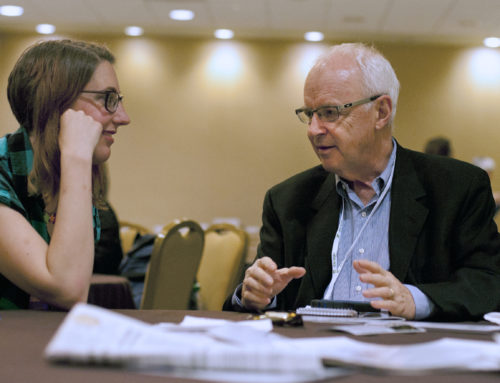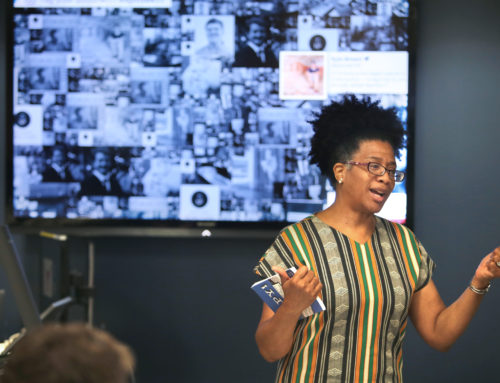RELATED ARTICLES “It Can Happen Here” | “Command Performance” from Rescue magazine | “Oklahoma City Blast: A Nation Responds” from Texas EMS Magazine
As a volunteer Emergency Medical Technician — Intermediate, Bradley Wilson, marketing specialist, Dallas, is qualified to provide street care to accident victims. As a freelance writer, he is qualified to recount experiences from such situations. These extra skills lead him to the Federal building bomb site in Oklahoma City.

Wilson, who continues to take EMT-I training classes, became certified in 1990. A college biology degree gave him an interest in the emergency medical field and a journalism degree provided an interest in writing. He has written articles for a community newspaper and for the Austin American Statesman. He also writes for Rescue magazine, a bi-monthly periodical of the emergency medical and rescue field. “Often there are people in rescue and EMS who aren’t journalistic,” said Wilson, “so there is a craving for people who have a medical background and are willing to write.”
Saturday, April 22, three days after the Oklahoma City bombing of the Alfred P. Murrah Federal Building, Wilson went to the site as a medical volunteer. Before he left he contacted Rescue magazine offering to write a feature on the emergency operation at the site. Once there, however, no medical personnel were needed-but he decided to stay as a reporter. “I started to walk around,” he said, “just watching the operation.”
Wilson made two trips to obtain information for his story, the second on Saturday, April 29. “By Saturday things were down to a real science,” he said, “The press was in a certain area and incident command was in a certain area.” Wilson explained the term incident command as a tiered, operational structure invoked to handle rescue and other related areas on a large-scale crime or disaster scene. “One single person is in charge. In this case it was the fire chief for Oklahoma City,” he said. This person designates responsibilities through the tiered structure to accomplish the enormous task at hand.
“It was the largest implementation of the incident command structure that has ever happened,” said Wilson. “Oklahoma City was fortunate to have a very trained crew. It was truly amazing to see how organized it was.”
Another duty within this structure was dealing with the press. “At one point there were probably 3,000 fire fighters, medics and police officers on the scene,” Wilson reported, “and 11,000 press people with two blocks of satellite trucks. It was true pack journalism.” A person from the command structure, usually the assistant fire chief, would speak to the press at 9 a.m. and 3 p.m. every day. Wilson called this ‘feeding’ the press. Frequent press conference “feedings” helped keep the media from getting in the way of operations.
Wilson also made a visit to St. Anthony Hospital, the closest to the Murrah Federal building. He reported area emergency rooms treated 460 victims after the bombing. Some of the injured remained as patients and received an uplifting surprise while he was there. “Two things cheered up the patients; the Dallas Cowboys and the search dogs,” said Wilson whose visit coincided with the Texas team who talked with and signed autographs for the patients.
The search dogs had worked earlier looking for survivors in the rubble of the bomb site. The dogs are trained to find a trapped person and distinguish whether a person is alive or deceased. “They wag their tail and bark if a victim is alive and duck their tail if they are not,” he said. “They could tell the patients were injured, but as soon as they recognized they were alive, they would perk up, tail wagging.”
Even the hospital suffered damage from the bomb. As an EMT-I and journalist, Wilson prepared himself for the wreckage of the federal building. “I was prepared for the building,” he said, “but I was not prepared for the mass destruction. All the news at that point was focusing on the federal building but there was destruction that went on for three to five blocks surrounding it. While I was there a building two blocks away collapsed. I parked three blocks from the site next to a building that had all its windows shattered.”
Another experience Wilson was not prepared for was the wide outpouring and show of support from everywhere for people involved in the tragedy. “I went up one street block and it was just covered with flowers, teddy bears, crosses and signs,” he said. “And that was just one street. Every street I walked down around the entire scene was that way.”
He was also impressed with the workers in the rescue structure he wrote about. “The fact that the rescuers worked 24 hours a day for 14 consecutive days was amazing. It was fascinating to be involved with a group of people where 100 percent of their job is to go out and help other people. They don’t get concerned about politics and all that, they’re concerned about saving lives.”
Wilson’s story will be published in the September issue of Rescue magazine. The issue’s main focus will be devoted to the Oklahoma City bombing.




Leave A Comment